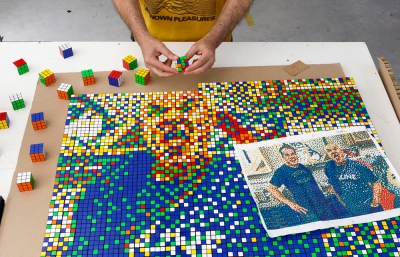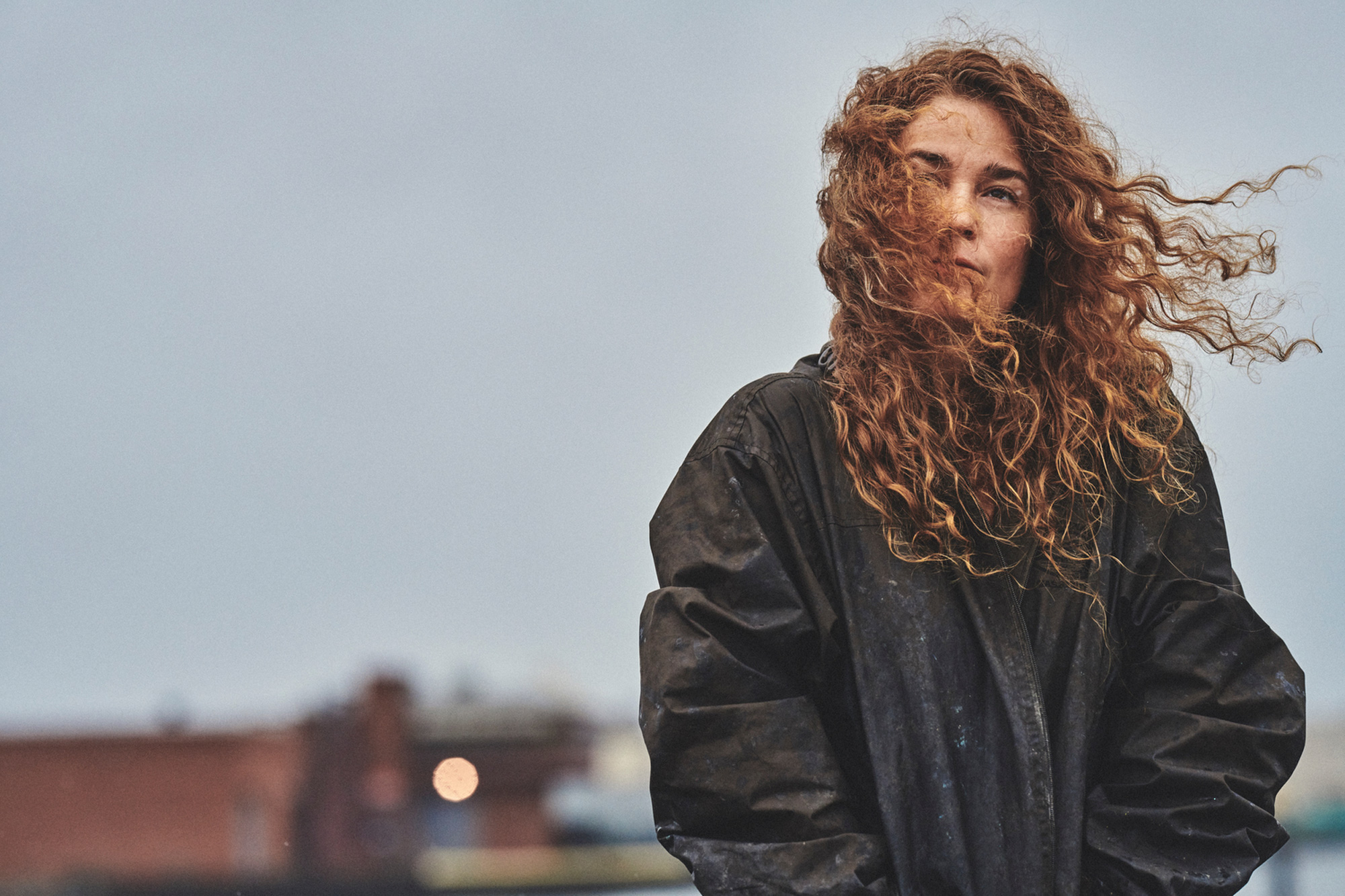
Swoon
The Catalyst
Interview by Kristin Farr // Portrait by Bryan Derballa
SWOON is an agent for change powered by Caledonia Dance Curry, and her empathy for humanity is boundless and borderless. Consistently using her art practice to foster healing, even referring to it as a balm, she has built shelter, creative jobs, and opportunities for therapeutic recovery from trauma through her community-based compassion projects. Her approach is inclusive, authentic and, working as a catalyst for positivity, the momentum she’s built is incomparable in the art world. Speaking with SWOON is a rare privilege, so let the wise sage speak and soothe.
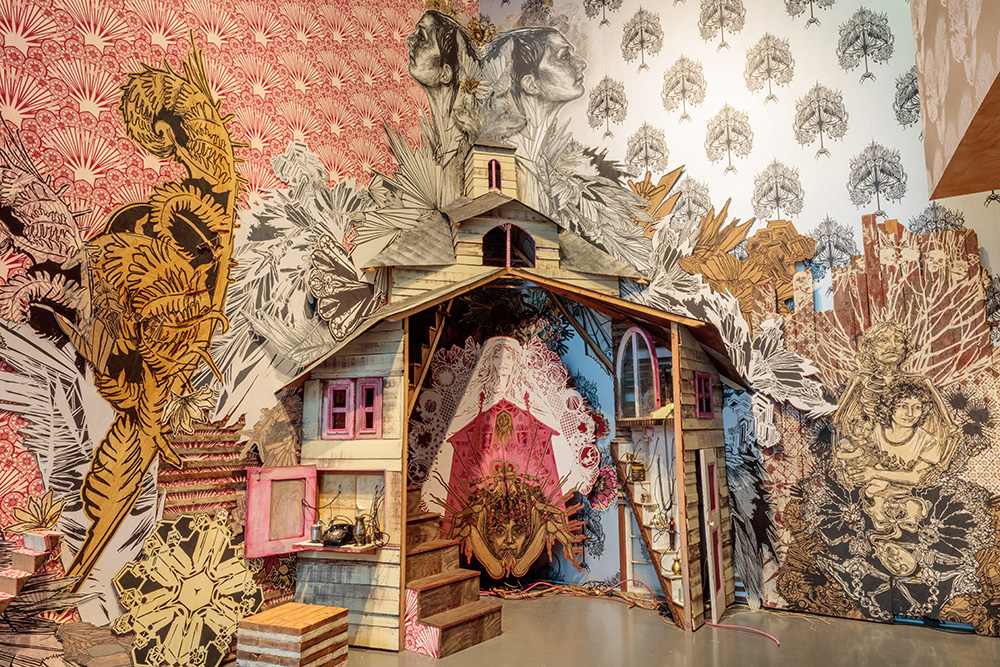
Kristin Farr: You’ve been taking this year to develop film projects, correct? Tell me about that and what else you’ve been up to.
SWOON: Yes, I’m teaching myself stop motion! I love it. I’m in love with adding the element of time to the visual world I’ve been building all these years. It opens up so much potential for the creation of meaning and narrative. And because our thoughts and dreams unfold over time, I really get the sense that time-based mediums speak to the subconscious in unique ways, which I’m enjoying playing with. It’s so much fun to take a deep dive and learn something solo, from scratch. My brain is all lit up in a new way when I’m working on a film piece. This summer, I took three months to just hole up, away from everything, and work on it. I was shocked to find that working alone, my pace is about a minute a month. It’s wild. I know stop motion has this reputation for being all-consuming once you’ve started, and that’s definitely been true for me.
The other thing that’s been really involving for me this year is work in Kensington, Philadelphia, a neighborhood that’s been hit especially hard by the heroin and opioid epidemic. Both of my parents were addicted to heroin when I was small, and learning to forgive and understand what in their lives led them to that place also made me realize that I care deeply about how we, as a culture, understand and help those of us who are struggling with addiction. So, when Philly Mural Arts asked me to work on a project addressing the opioid crisis, I found I couldn’t say no.
The first stage was for myself and three collaborators, Jessica Radovich, Julian Mocine-McQueen and Heather Box to spend three weeks in Kensington giving daily workshops at a community space run by Mural Arts in the hardest hit area. It was really a heart-wrenching experience to see the level of suffering that people are in. And when you talk to people who are addicted to heroin and living homeless, it immediately becomes clear that every person out there has a history of severe unhealed childhood trauma for which heroin is an attempt to manage the pain. Through my study of the literature on addiction and through my experience in Kensington, and with my own family, it’s my belief that no one ends up in such a dire situation as being homeless and addicted to heroin without being in a kind of pain that most of us cannot even imagine. The heroin is being taken out of sheer necessity in an unhealthy attempt to soothe a pain that they have never been given adequate help to heal from. The next step for this work is going to be a conference headed up by Dr. Gabor Mate whose book, In The Realm of the Hungry Ghosts, changed my life, and helped me to forgive my parents as well as understand the traumatic roots of addiction. The conference is going to focus on helping people understand the relationship between trauma and addiction, as well as looking at some of our most promising trauma treatments, from EMDR and Somatics-based therapies, to the MAPS trials, which are studying the potential of MDMA assisted therapy to treat PTSD.
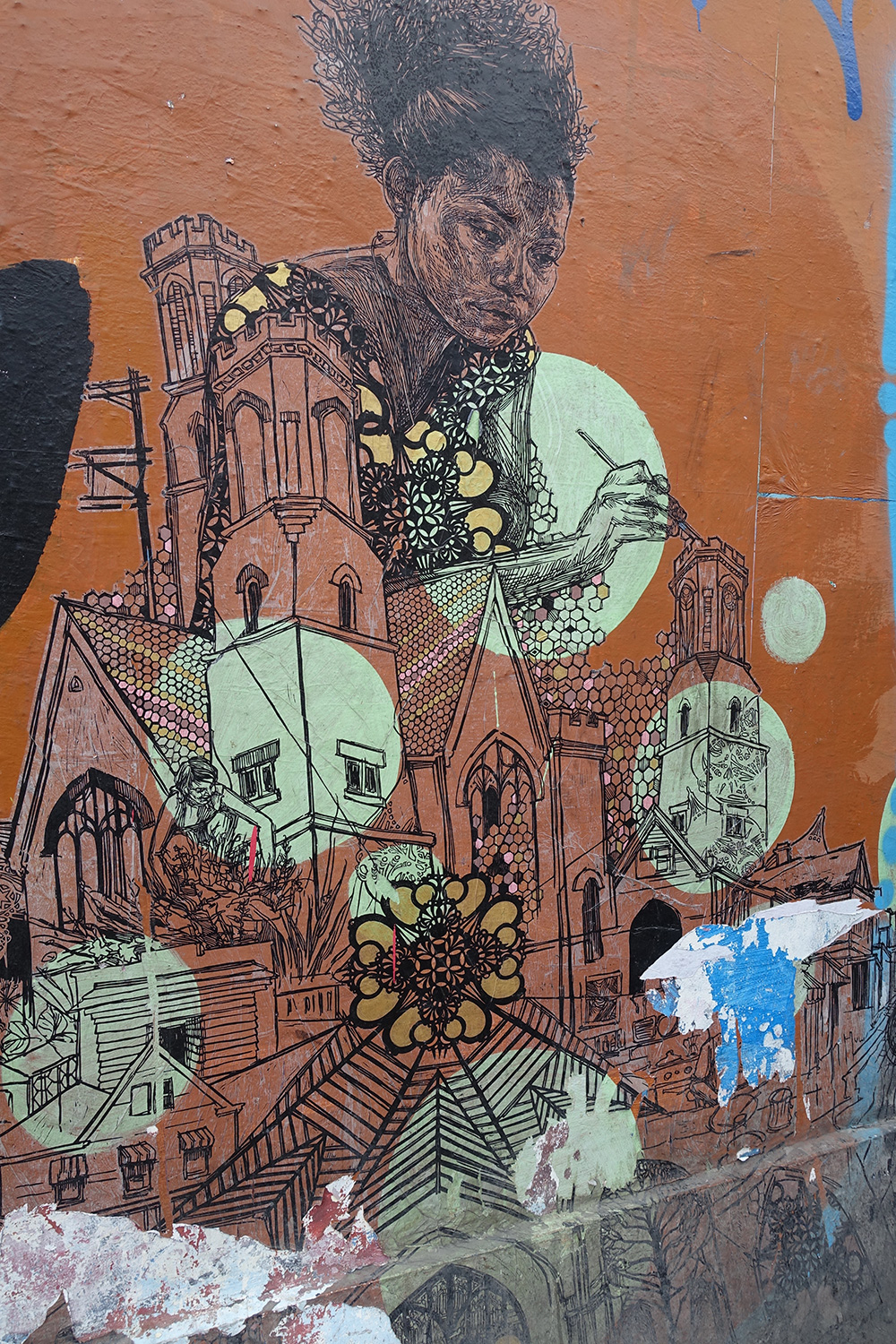
Your efforts to dive in and understand the crises of our lifetime show incredible commitment. What’s new with your Heliotrope Foundation? The first three projects seem to be really thriving and impactful.
At the moment, Heliotrope is focused on finishing up work in Haiti in such a way that the homes and structures we helped build there can be maintained for posterity. Natural building techniques take a lot of maintenance, and because each of these buildings represents a re-emergence of old techniques cross-pollinated with modern technologies and materials—meaning, in their own way, they’re a new proposition—it’s taking some figuring out to develop the best, easiest, and most affordable maintenance techniques that people can continue on their own. This phase of the work really hammers home for me what a long arc is required for community-based work to succeed. There were the initial disaster relief phases, the continued building phases, and now, the often invisible, or often not completed, phase of fine-tuning and making sure all the pieces are truly in place for the future.
I went to the Music Box in New Orleans, and it is one of the most authentically magical places I’ve ever visited. What made you turn a house into a musical instrument in the first place? It’s now expanded to be a venue full of musical treehouses.
I’m continually in awe of the folks at the Music Box and what they’ve created. When I first started a collaboration with them, I certainly had no inkling it would become what it is. New Orleans Airlift just has this magic combination of long term community roots, renaissance ingenuity, and deep willingness to sacrifice to make unlikely things happen. I’ve honestly never seen anything like them. I first started working with them when my friend Jay (airlift co-founder) had a house on his property that was going to have to be demolished post-Katrina. He asked if I wanted to create a sculpture with the house before it came down, and I proposed an idea for a musical sculptural installation that would embed itself inside and be played out to the street. I loved the street music and Second Line culture of New Orleans, and on the raft projects, I had been constantly trying to crack this code of how to embed performative, interactive musicality within our handmade mobile structures. So, those thought processes weaved together and came out in my proposal to Airlift, which turned out to have so many rich interpretations. Early on, the project really became their heart and brainchild, and has continued to unfold and grow ever since.
Talk about the idea of homes and dwellings, both symbolically and physically, because they seem to be metaphorical in all aspects of your work.
You know, it’s so funny, but my first complete short film, which is about two-and-a-half minutes long, begins and ends with a splitting house. The house is really the container for everything that happens in the piece, and, in a way, represents a container for the psyche. I started film because I needed a break from these huge building projects, and here I am, right back at this central image of the home. I didn’t even particularly connect that until you asked. The first time I built a raft, I remember being overwhelmed by this feeling that my friends and I had done something absolutely elemental to being human. I later looked into the history of boats and found that skin canoes date back to before modern man, so our relationship to boats is as old as we are, and, I think, so is our relationship to shelter.
We have a rich history with painting as an art form, but homes are even older and more deeply rooted. I find myself returning to them over and over again, sometimes as temples or sheltering spaces, sometimes as anarchic symbols of self-created freedom, sometimes as symbols which hold stories, divulge secrets and teach me things.
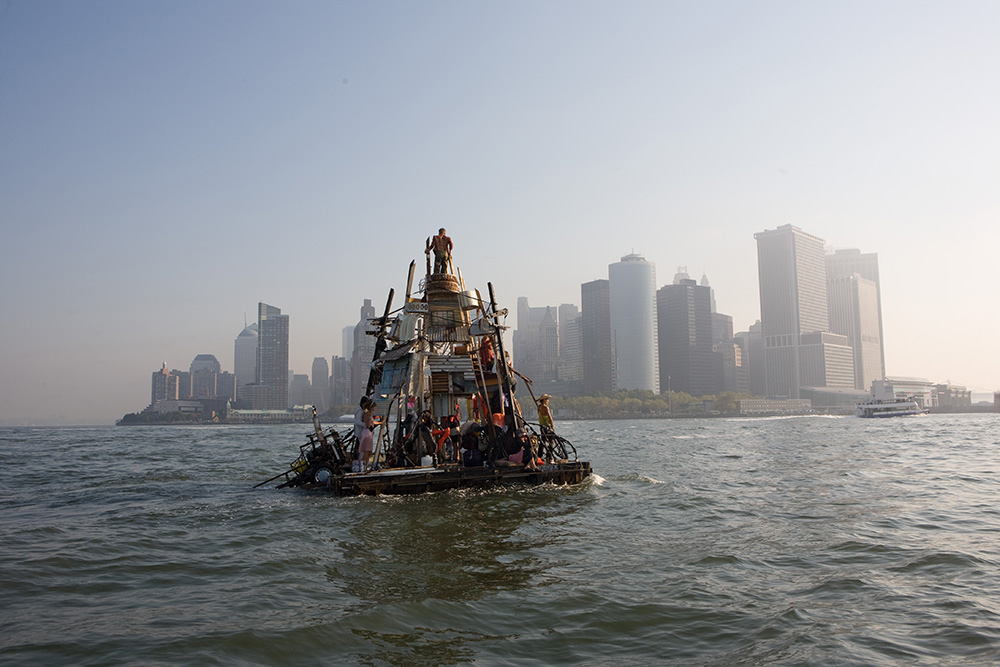
So much personal memory originates in the home. I’ve noticed that shadows also seem important in your installations, and wondered how you think about them, both visually and also with the notion of “shadow selves.”
The shadow self is a strong line of inquiry these days. I’ve thought so much about consciousness lately, and I find myself asking the question of how much of ourselves we are capable of bringing to it—and what we, as individuals, as well as society, stand to gain when we do that work. While exploring this, I’ve begun to see that the deeper something is buried inside us, the more power it has to direct our lives without us realizing it, almost as if its distance from the surface of consciousness represents some form of invisible leverage. The further something is from the fulcrum of conscious awareness or acceptance, the more power it has to turn our gears.
In the last few years, I’ve unearthed some very old, deeply buried pains and fears, and found that I’m subsequently so much less likely to seek out people in my life to play out chaos and pain with. The buried pain isn’t driving me to be seen anymore, because I’ve looked at it directly. I’ve held it and accepted it. The ripple effect of embracing the shadow side of the self can be huge, and not just for individuals. Look at all the damage that’s being done to our society by repressed conservatives who try to control others because they can’t accept what feels unacceptable in themselves. And, of course, the shadow is super rich territory for art making because of its buried subconscious nature. Art can help us access parts of our consciousness that talking or busy-mind thinking can’t. Art can also reflect our consciousness back to us, and become a way of seeing and tangibly working with the raw material of who we are.
I’m interested in the Thalassa portrait. Is she a real person, or is she the Greek goddess version? What message does she carry for you?
Thalassa is a primordial incarnation of the sea. Almost pre-goddess. For me, Thalassa is that moment when I stand before the ocean and every cell of my body calls out “Mother. You are me, and I am you, only you are infinitely vaster.” She’s based on one of those people who’s instantly unforgettable, a friend of mine named Naima Penniman, one of the most beautiful, brilliant, compassionate people I know. She has spent her life dedicated to art and social justice, racial justice, eco justice, and is someone who understands herself as divinely connected to the sea.
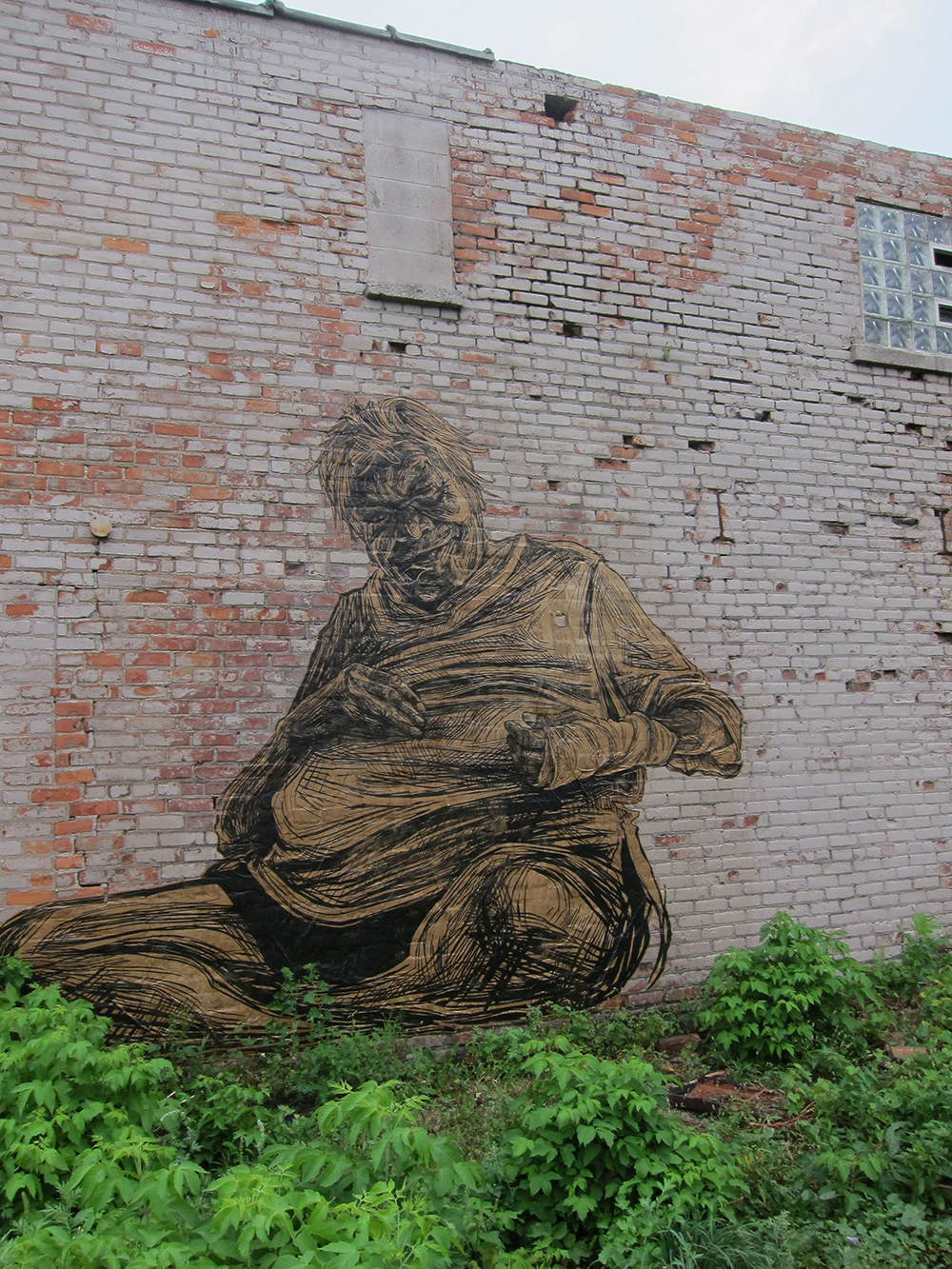
I’m also curious about others in your portraits, like Mrs. Bennet or Neenee. Who are they? Do you have stories about them?
Mrs. Bennet is a painter I met a few years ago, who has since passed away, one of the first Australian Aboriginal women to translate Aboriginal sand painting into a canvas-based storytelling medium. I was so moved by her presence and the force of her work that I wanted to honor her through a drawing. Neenee, a girl I met in Braddock years ago when we were first working on the church, worked alongside us for a summer, and she became the biggest part of a portrait that represents lots of folks in Braddock, embodying the story of our work there. My parents became really prominent in my work over the last few years, particularly representing them in a way that symbolizes our universal mortality, and using portraiture as a way to see them and love them and grieve their passing. This year, I’ve stopped making block prints, which is a big shift, but I’m still drawn to making portraits.
What is the last thing or person you drew? Have you had any recent developments or obsessions in your drawings?
The last thing I drew was my friend giving birth. Birth is definitely a drawing obsession of mine. I want to see that aspect of women’s bodies and lives portrayed large and in your face in a very celebratory, embracing way.
What purpose does street art fulfill now, versus when you started wheatpasting in the streets 20 years ago?
Well, there’s certainly been a big shift in the definition of street art. When I started, it meant quickly executed illegal interventions that were about rebellion, pushing against the boundaries of the city, and trying to claim public space for the commons, and just a wild, unbridled, layered, messy, subject-to-the-elements kind of creativity. The definition has slowly evolved to mean big mural projects, usually executed legally with budgets and boom lifts, and often a plan for changing a neighborhood. I’d say the two things are pretty different. Under the right circumstances, I love them both, but I definitely think there’s been a shift that hasn’t been really articulated.
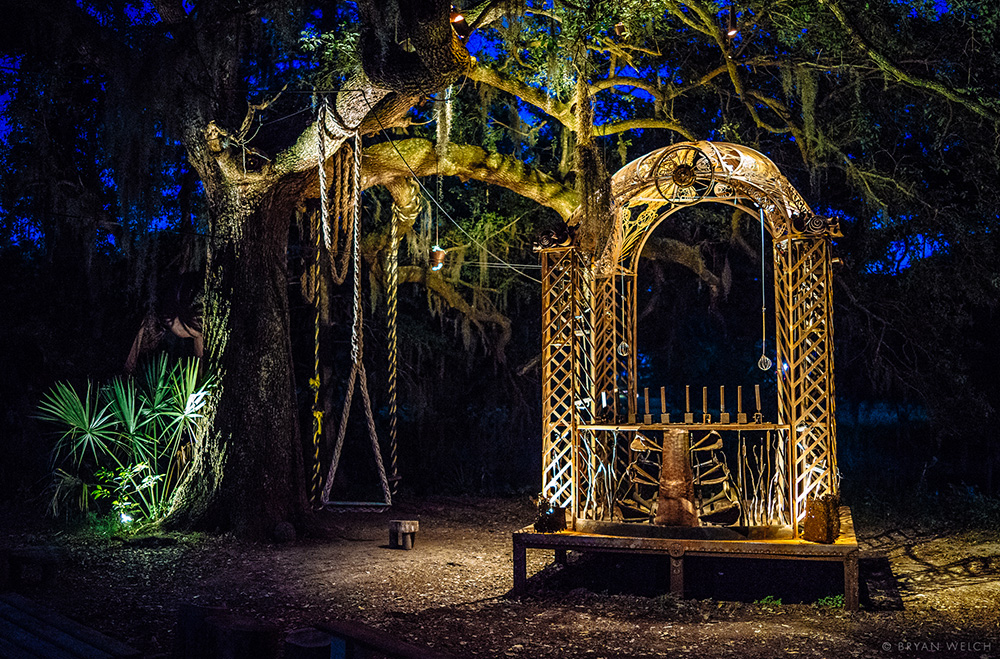
Swimming Cities of Serenissima opened perspectives as to what contemporary art could be. I remember being awestruck and thinking the Adriatic Sea must’ve been so gnarly! What’s your perspective looking back on the raft projects, and how did the philosophy you developed back then influence future work?
The first project that came directly out of the raft projects was the reconstruction work in Haiti. It might not seem obvious, but with the rafts, my friends and I were truly moving mountains, doing the most mad-scientist, unlikely things, getting past all kinds of red tape, raising money out of thin air, and braving up to all manner of terrifying situations. I remember thinking, if we can make this flotilla happen, we can do this in a situation of real need as well, like when a disaster strikes, because we’ve really honed a very specific set of skills. And the performative aspect on the rafts led directly to the architecture of The Music Box. The raft years sent ripples throughout the community of artists involved. It was one of those projects that never would have happened if it weren’t for the brilliant, hard-working, creative people who came together, and there are lots of other projects, from Todd Chandler’s movie Flood Tide, to the band Dark Dark Dark, to boat trips in India and down the Klamath River, to Camp Tipsy out in San Francisco; they are all kin to those original raft trips.
It’s nice to hear about these threads weaving each project together. SInce you’ve always used your platform to influence social change, how are you handling the current political mess? How do you continue to approach the world with love and empathy in these appalling times?
Right from the beginning, I found that in making art that interacts with the world, there’s an inherent, potentiating force for change, and you start to ask, well, if the very existence of this is effecting change, what kind of change do I want that to be? However, I definitely maintain a lot of space to make “art for art’s sake” because I think that the singular freedom that this act contains can be radical in its own right. Right now, the limits of my compassion are definitely being challenged. My process involves a lot of meditating, a lot of grieving over the worst of my sadness and raging the worst of my rage before I make things public. That way, I know I’ve done my work, and I know my way around my feelings enough to be sure that what anger I do express is being fueled by the fires of love, rather than fueling something more toxic.
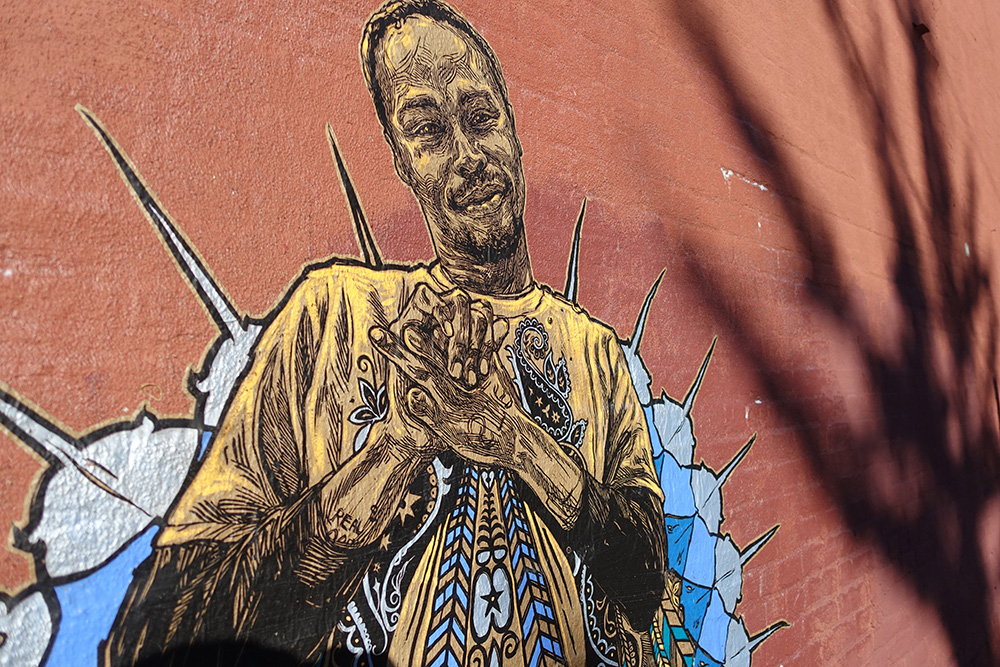
You’ve asserted that, “All I want in the world is to make something that feels like a balm,” and your work does support healing in times of crisis. Have you had challenges navigating communities in crisis, in terms of misconceptions about your agenda as an artist from the U.S.?
There have definitely been misconceptions and criticism of some of my community-based work, but pretty much always from the outside, often in a fairly armchair sort of way. Which is not to say that there aren’t fair criticisms to be made; there absolutely are. I just get the sense that the most vocal folks are generally working from a couple college papers they read and then want to try on what it feels like to call someone out. People who do long-term, community-based work tend to have a visceral understanding of the level of sacrifice it takes to commit to being useful to a community that has experienced crisis, so they tend to be more measured and nuanced in their criticism, because they really know what goes into it. With work this complex, there will always be room for criticism. Sometimes there are choices to be made where you know that something is not perfect, but nonetheless worth doing.
The very fact of me being a white person bringing resources and skills into Haiti absolutely plays into the colonial forms of aid that we see in Haiti. Yet, there was a crisis, and I believed the work was worth doing in spite of this inherent problem. I think sometimes people forget that it’s not as though I began working in Haiti out of some generalized belief that people in Haiti didn’t know how to manage the circumstances of their own lives, an attitude that shows up in the worst kinds of charity projects. I began working there because of a devastating earthquake, and I found the process was longer than expected. It wanted to unfold over years and years, not months and months.
What’s a recent story of connection that happened through your work?
I think the most moving creative connections I have felt recently have been when I share my personal history and when I work out the trauma of growing up with addicted parents through art and writing. People have said a lot of things that reduce me to blubbering tears because they go straight to my heart, and they make me realize how something I had only dreamed about would be able to function in a way that people could receive it.
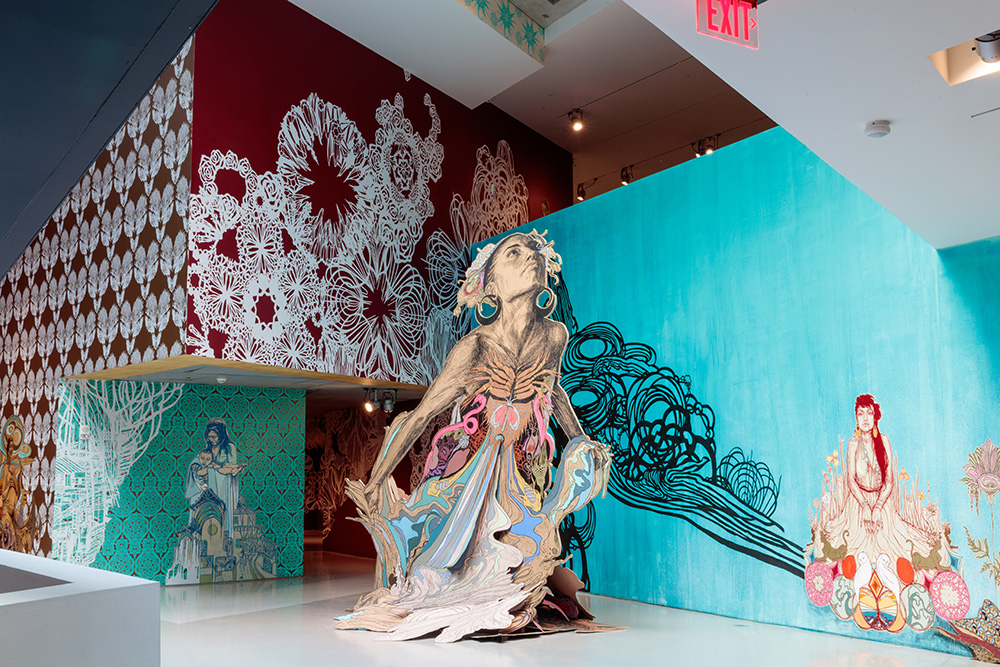
I’ve had people reach out and thank me for making or articulating things that helped them to see and feel experiences in their own lives which were otherwise held under the fog of traumatic dissociation. In those moments, I feel a surge of connectedness, and I feel grateful to be a link in the chain that once held me together, and now getting to be a part of holding someone else together. It really is pure magic.
I wonder where your middle name came from, and if you ever get on the dance floor and shout, “Dance is my middle name!”
I do get a little crazy when I dance! It was a name that came from my dad. I’m not entirely sure why he named me that, except that he was eccentric and a poet by nature, and he wanted to give me a name that made me feel alive. It definitely worked.
What’s the last body of water you swam in, and how did it feel?
I’ve been learning to surf in the Pacific, and it’s been life-changing. It feels like waking up to the fact that there are physical conditions to my own happiness, and here they are.
Where are you traveling to next?
I’m on a plane to Japan for a show at the Mori Museum!
"Catastrophe and The Power of Art" is a group exhibition featuring SWOON at the Mori Art Museum in Tokyo through January 20, 2018.
swoonstudio.org




